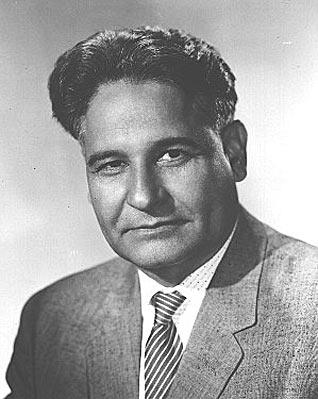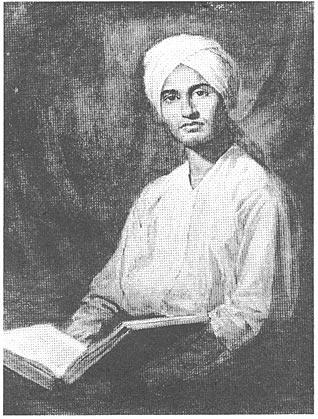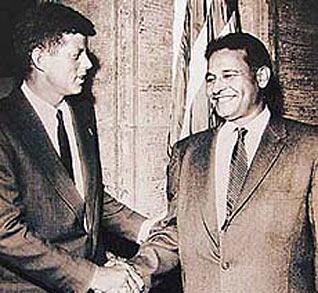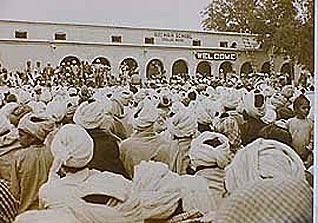Columnists
Dalip Singh Saund:
America's Lawmaker
ROOPINDER SINGH
From Chhajalwadi, near Amritsar, he went to the US Congress and left a mark that still sets him apart from the many who followed him. In the shadow of the changed situation in America after 9/11, the focus is again on someone who created history many years ago. Sikh-Americans and other persons of Indian origin in America, as well as other minorities, are re-discovering this extraordinary man.
Dalip Singh was the first American of Asian origin to be elected to the US Congress - not once, but three times! No other American of South Asian descent has managed this feat even once so far.
But it was a long haul for the son of Natha Singh. Born on September 20, 1899, in the village of Chhajalwadi, Dalip Singh grew up in a joint family, the elders of which were engaged in farming as well as the construction business. One of his three brothers was Karnail Singh, who retired as Chairman of India's Railway Board in 1962 and who was renowned for his engineering skills. Unlike his elder brother, Karnail Singh did not use the family name.
"Dalip Singh was a serious-minded person and interested in public work from an early age. He prevailed upon his parents and made them start a school in the village," says Anup Singh, Karnail Singh's son.
He studied in a school in Baba Bakala, near Amritsar, and at the Prince of Wales College, Jammu, where he earned his BA in Mathematics from Panjab University in 1919.
He persuaded his family to help him pursue further studies in America, so that he could learn about food canning and open up a factory in India. "I assured my family that I would study in the United States for at least two, but certainly not more than three years, and would then return home," he later recollected in his book, Congressman from India (1960).
In 1920, he studied food preservation at the College of Agriculture, University of California, Berkeley, and lived in an accommodation maintained by the oldest gurdwara in the USA - The Sikh Temple in Stockton. He also took additional courses in mathematics and later switched to that field, earning first a Master's and then a Ph.D. During this period, he was active in the "Hindustani Association of America" and was elected its national president after two years.
By this time, it was 1924 and the young man apparently sought a teaching assignment, but none was forthcoming. His first job as foreman of a cotton-picking gang required no schooling. He also worked in various canning facilities.
"In the summer of 1925, I decided to go to the southern California desert valley and make a living as a farmer." At this time, Dalip Singh was still a turbanned Sikh, though later he felt compelled to doff it.
The farming experience was not an easy one. His first lettuce crop was a financial loss because of overproduction. He also took to selling fertilizer. He found the time to write My Mother India (published by the Stockton Gurdwara in 1930), a rebuttal to Catherine Mayo's Mother India, a blistering attack on India doing the rounds at this time.
Dalip Singh had been involved in politics throughout. According to his nephew, Anup Singh, it was on the advice of Indian leader Madan Mohan Malaviya that he decided to settle in America. The heat from the colonial authorities regarding his Ghaddar activities had made it uncomfortable for him in India. [Editor: The Ghaddar Movement was an extension of the Indian Independence Struggle, as it surfaced primarily in the U.S. and Canada, with a majority of its members being Sikh - as was also the case amongst the freedom-fighters back in India.]
But in America too, Dalip Singh continued with his public-speaking engagements, both in the gurdwaras and elsewhere. It was during a talk he gave at the Masaryk Club that he met Marian Kosa, the woman who later became his life partner.
According to Gurinder Singh Mann, Kapany Professor of Sikh Studies at the University of California's Santa Barbara campus, Dalip Singh had earlier met Marian "on a ship while traveling from London to New York."
"In 1928, they married," he adds. "As an Indian, Dalip Singh could not become a U.S. citizen, because a Federal law dating from 1790 declared that only White immigrants were eligible for citizenship. Kosa, although America-born, had to give up her own citizenship to marry him."
When they first met in California, she was a student of the University of California at Los Angeles (UCLA). Her father, Emil Kosa, Sr. was an artist who had migrated from Hungary in 1907. Her brother, Emil Kosa, Jr., was a famous Californian painter known for his landscapes. He worked in the 20th Century Fox studios as a special effects artist. He won an Oscar in 1963 for his work on the film, Cleopatra, and worked on movies that included Doctor Doolittle, The Sound of Music and John Goldfarb, Please Come Home.
Dalip and Marian Saund had three children. The eldest, Dalip Jr., was born in 1930, followed by his sisters Julie and Ellie.
The children, it is reported, experienced discrimination as they were growing up. According to an account by author Tom Patterson, they were sometimes referred to as "half-breeds". Of course, this has to be seen in the context of the 1920s which was a tough period for immigrants since anti-immigration laws were on the rise.
The discriminatory attitude in Westmoreland is ultimately the reason for Marian and the children moving to Los Angeles in 1942, though it is publicly ascribed to an "allergy problem" she had. Marian was a teacher and, incidentally, the children did well for themselves, with Dalip Jr. studying mechanical engineering at the California Institute of Technology and doing a Doctorate in Anthropology from his mother's alma mater, UCLA. He also served as an officer in the Korean war.
Later, tragically, he was killed in a flying accident.
Julie and Ellie took to their mother's profession of teaching after graduation from UCLA. Julie Saund Fisher married a famous oceanographer and has four sons who are living in California. Ellie Saund Ford has two children, a son and a daughter, according to family sources in India.
The passage of the 1946 Luce-Celler Bill marked a watershed in the way the Americans treated immigrants. It liberalised immigration and Dalip Singh was one of the early petitioners for citizenship. Till then, though active in politics, he could not hold any elected office before he became a citizen, which did not happen until 1949.
Talking about his contribution to the Indian diaspora, Dr I. J. Singh (a Guggenheim Fellow in 1960 and currently Professor of Anatomy at New York University) says: "He was a man of principles. He supported the Ghaddarites because he supported demands for India's independence. His contribution to the struggle of all Asians for citizenship was strong and memorable."
Within a year of becoming a citizen, Dalip Singh was elected judge of Justice Court, Westmoreland Judicial District, in the Imperial Valley County, but following a lawsuit by local businessmen, he was denied the seat because of the technicality of not having been a citizen for one year when elected.
That there had been resentment about him is obvious from the following anecdote narrated by him about his 1952 campaign for the same post:
"One day, just three days before the election, a prominent citizen who was opposing me bitterly saw me one morning in the town restaurant and said in a loud voice: ‘Doc, tell us, if you're elected, will you furnish the turbans or will we have to buy them ourselves in order to come to your court?' ‘My friend,' I answered, ‘you know me for a tolerant man. I don't care what a man has on top of his head. All I'm interested in is what he's got inside it.' All the customers had a good laugh at that and the story became the talk of the town during the next few days."
He was elected judge of the same court in 1952 and served until his resignation on January 1, 1957. He is credited with cleaning up the red light district of Westmoreland by awarding stiff fines and jail sentences.
Dalip Singh's eyes were now set on a seat in the Congress. His family, including his son Dalip Jr. and daughter-in-law Dorothy Saund, took active part in the intense house- to-house canvassing. After winning the party primary, Dalip Singh was eventually pitched against a Republican candidate, the glamorous and wealthy Jacqueline Cochran Odlum, who had been a beauty salon operator and a pilot.
It was a much-watched fight. Dalip Singh was accused of being a "foreigner" and of having been sued by his creditors. He successfully negotiated the first issue and explained his position on the second. (He had not sought the bankruptcy option that several other farmers had chosen. He had eventually paid off the creditors, something that those who declared bankruptcy did not have to do.) He was a victor by 3,300 votes, the first Democrat to have won from the constituency and the first Asian American to do so.
Dalip Singh's fame had already spread and in a rather unusual honour, he was given a seat in the House Foreign Affairs Committee, which would normally have gone to a senior Congressman.
In 1957, he was sent as an official emissary of the House of Representatives to tour various Asian countries, including Japan, Vietnam, Indonesia, Singapore, the Philippines and India. Anup Singh recalls that his wedding had been planned to coincide with this visit and the invitations went out in the name of Saund, who was welcomed wherever he went, be it Calcutta, New Delhi, Bombay or various places in Punjab, including his village. "He spoke in beautiful Punjabi," recall old-timers who heard the Congressman at that time.
Dalip Singh was re-elected to the Congress in 1958 and again in 1960.
But he suffered a severe stroke as he was preparing for re-election to his seat in the House of Representatives, in May, 1962. The stroke left him paralyzed on the right side of his body. He was able neither to speak nor walk, even with the help of a walker. But with the devoted attention and support of his wife, he was able to move from his bedroom to the living room chair.
The dynamic man who had created history, died on April 22, 1973. He is still remembered by many for his devoted contribution to the public life of America and his uncomplaining attitude towards all problems, despite the discrimination he faced at various points of his life.
"As we now sometimes face discrimination and harassment - often, because of mistaken identity - it is good to remember how people like Dalip Singh Saund faced heavier odds and prevailed. When we bemoan the glass ceiling that we encounter sometimes, it would be good for us to recall how a young Ph.D. in mathematics toiled on a farm, for that was all he was allowed to do. He opened many doors to us. In our success in this multicultural land, we stand on the shoulders of giants like him," says Dr I. J. Singh.
As Gurinder Singh Mann puts it: Dalip Singh Saund lived through several phases in the history of Sikhs in America. At the time he began his life in the United States, he could not even become a citizen. By the end of his life, he had not only done so but had taken an active role in the government. His achievements are a landmark in the history of not only Sikh immigrants, but also that of other Indians and Asians in the U.S.
Indeed, as they say, with hard work and commitment to service, one can go far in the United States of America.
[Courtesy: The Tribune. Edited by sikhchic.com, with input from Eric Saund, the Congressman's grandson.]
Published on March 17, 2007; Revised on March 12, 2015
Photos: First from bottom - Dalip Singh Saund being welcomed by a crowd at the school he had helped found, during his early life, in his village in Punjab.
Second from bottom - With President John F. Kennedy.
Third from bottom - a portrait of Dalip Singh Saund, painted by his brother-in-law, Emil Kosta Jr.
Conversation about this article
1: Jay Singh (London, England), March 18, 2007, 8:16 AM.
Well, I am glad that Sikhs are finally embracing Saund - as an icon for Sikh-Americans, he is immense. However, in the past, I have sensed that because he was "mona", some Sikhs had difficulty in having him as a possible role model. Let's hope this changes.
2: Harinder (Pune, India), April 06, 2007, 2:56 AM.
It is obvious that the challenges we face in our daily life today are peanuts compared to what our fore-fathers went through.
3: Roopesh Tyagi (INDIA), April 14, 2007, 10:54 PM.
He has done all Indians proud. I am one of them. Will do some good to myself if I follow my path with the same zeal! That's called Chardi Kalaa.
4: Nirmal Singh (India), July 13, 2007, 11:30 PM.
I feel proud of Dalip Singh Saund's contribution but alas, his countrymen in general, and Sikhs in particular, are largely unaware that he was the first Asian, not just Sikh or Indian, to become a Member of U.S. House of Congress. It was he who forced the U.S. Government to enact a law granting citizenship to Sikhs and others from the subcontinent. We cannot forget his contributions. He was really a great Sikh-American!
5: Gurbux Singh (Chatsworth. U.S.A.), September 19, 2007, 2:23 PM.
In 1957, my father - the late S.Tara Singh of Burma - was in Thailand representing Burma in a golf tournament and had the privelege to meet Dalip Singh Saund who was there on a goodwill mission of Asian countries. My father managed to have him come to Rangoon, Burma and we had an opportunity to hear him speak at the Sikh Temple. I was just a young teenager at the time and vividly remember him coming to our house with my father and having dinner. Since my father was a licensed Ham radio operator, Dalip Singh Saund was able to talk by radio to a few radio hams in India as facilitated by my father. I remember him as a very down-to-earth gentleman and unpretentious even though he was a US congressman. My family has some photographs of the visit and still cherishes them.
6: Mira (Trinidad, West Indies), September 03, 2009, 9:27 PM.
Dalip Singh Saund must be applauded for his tireless contribution to the Unites States and an honoured achievement that makes people of Indian ancestry proud. But unfortunately he lost his rich cultural Sikh legacy. It is sad that none of his children became Sikhs or were aware of their father's religion or the great country their father came from. let this be a lesson to all of Indian ancestry whereever we are born or grow up: when adopt new homelands, let us never forget our own rich culture or religion. Otherwise, it would be lost forever and nothing would be there for the future generations.
7: Aman (U.S.A.), December 01, 2009, 2:28 AM.
He makes me proud of being a Sikh- and Punjabi-American.






